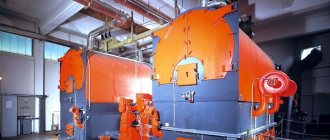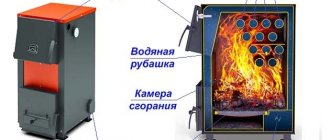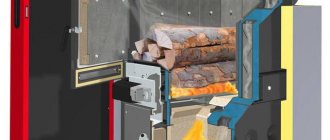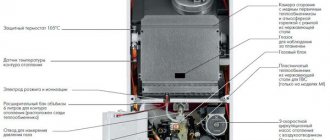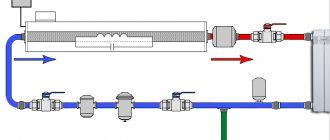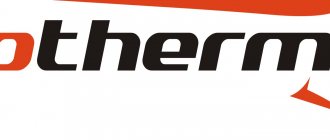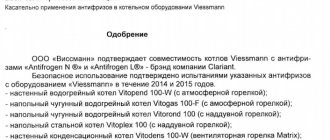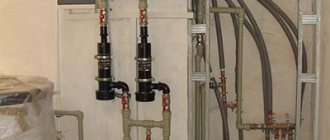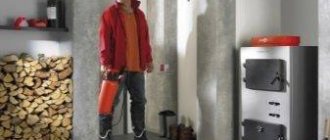What are hot water boilers used for?
These units are intended for heating buildings with a small area, private houses and town houses. As a rule, such boilers are installed in those settlements where there is no central heating, or, alternatively, the installation of a boiler room is impractical. Be that as it may, the concept of “hot water boilers”, and regardless of the specific design and model, means devices capable of generating thermal energy (due to their technical parameters) when burning a particular fuel, and then directing it to the working fluid (coolant ), which is usually water. And when this water, accordingly, circulates through the heating circuit pipeline, the temperature in the house rises to the required value.
Low temperature liquid fuel hot water boilers
Two-pass low-temperature water heating boiler for operation on liquid and gaseous fuels Rated thermal power: 110 – 620 kW
Two-pass low-temperature boiler for operation on liquid and gaseous fuels Rated thermal power: 621 – 2,000 kW
Three-pass low-temperature boiler for operation on liquid and gaseous fuels Rated thermal power: 90 – 560 kW.
Three-pass low-temperature boiler for liquid and gaseous fuels Rated thermal power: 700 – 1,950 kW.
Three-pass low-temperature boiler for operation with liquid and gaseous fuels Rated thermal power: 90 – 500 kW
Three-pass low-temperature boiler for operation with liquid and gaseous fuels Rated thermal power: 620 – 2,000 kW
Low temperature cast iron three-pass water heating boiler for liquid and gaseous fuels Rated thermal power: 125–270 kW
Low temperature cast iron three-pass boiler for liquid and gaseous fuels Rated thermal power: 320-1,080 kW
Low pressure steam boiler
Steam power: from 0.26 to 2.2 t/h.
Design features, classification by temperature and method of execution
The hot water boilers found on the shelves today have a relatively identical design. Significant differences lie in specific manufacturers (they are both foreign and Russian), as well as in the maximum power of the equipment.
If we talk specifically about design features, then from this point of view, boilers can be gas-tube (or, as they are also called, fire-tube) and water-tube. Let's take a closer look at each of the categories.
- Fire tube models. Their distinctive feature can be considered the presence of special tubes through which heated combustion products of energy carriers move. As for the operating principle of such equipment, it is based on the use of automated burners equipped with blower fans. Thanks to the smoke tubes, the water outside them is heated. It is worth noting that such models are almost never used in everyday life.
- Water tube models. They are characterized by special boiling tubes through which the coolant moves. And fuel combustion products are used to heat these tubes. Water-tube boilers warm up quickly enough, you can easily adjust them if the loads change. In addition, the operation of this equipment also involves the possibility of serious overloads. As for the explosion hazard of these boilers, it is at a fairly low level.
Note! All hot water heating devices are also divided according to their temperature level. Thus, the maximum permissible temperature for low-temperature models is 115 degrees, while hot water boilers that overheat water can “boast” a higher figure - about 150 degrees or more.
Note that the low-temperature operating mode provides for fairly economical fuel consumption, but at the same time condensation appears on the surface of the device, which can negatively affect materials in contact with the products of combustion of energy resources. For this reason, extremely stringent requirements are placed on the materials used in the production of boilers.
Units that generate superheated water are characterized by a long service life and high reliability. During operation, they make virtually no noise, and waste emissions are minimal. These units are also equipped with convenient and simple control systems. They are installed quickly and do not require labor-intensive maintenance.
Classification of steam and hot water boilers
General information
Classification of steam and hot water boilers
Steam boilers of small and medium capacity
Steam energy boilers
Creation and improvement of hot water boilers
Low power water heating boilers
Hot water boilers for municipal energy
Hot water boilers for district heating
List of used literature
List of used literature
1. Borisov M.A. Rehabilitation of TES. Security of the work of the integrated energy system of Ukraine // Energy and electrification. – 2004. – No. 3. – P. 2–3.
2.Erofeev V.L., Semenov P.D., Pryakhin A.S. Thermal engineering: Textbook for universities. – M.: Akademkniga, 2006. – 488 p.
3.Oxford illustrated encyclopedia. – T. 6. Inventions and technologies / Ed. Monty Finniston. – M.: Publishing house “Ves Mir”, 2002. – 406 p.
4.Petrov V.S., Goncharenko V.G., Pogarova L.S. Problems and prospects for the development of thermal energy in Ukraine // Energy and electrification. – 2001. – P. 42–44.
5.Prokopenko A.G., Mysak I.S. Stationary, variable and starting modes of power units of thermal power plants. – M.: Energoato
Mizdat, 1990. – 316 p.
6. Ryzhkin V.Ya. Thermal power plants: Textbook for universities / Ed. V.Ya.Girshveld. – 3rd ed., revised. and additional – M.: Energoatomizdat, 1987. – 448 p.
7. Sterman L.S., Lavygin V.M., Tishin S.G. Thermal and nuclear power plants: Textbook for universities. – 2nd ed. – M.: Publishing house
in MPEI, 2004. – 424 p.
8. Taud R. Prospects for the development of thermal power plants using organic fuel // Thermal power engineering. – 2000. – No. 2. – P. 68–72.
9. Heat engineering / B.Kh. Draganov, A.A. Dolinsky, A.V. Mishchenko, E.M. Written; Per ed. B.Kh. Draganova. – K.: LLC “Astra Pol”, 2005. – 503 p.
10.Power installations and the environment /V.A. Malyarenko, G.B. Varlamov, G.N. Lyubchik et al. / Ed. V.A. Malyarenko. – Kharkov: KhGFGH, 2002. – 397 p.
General information
Classification of steam and hot water boilers
Steam boilers of small and medium capacity
Steam energy boilers
Creation and improvement of hot water boilers
Low power water heating boilers
Hot water boilers for municipal energy
Hot water boilers for district heating
List of used literature
Classification of steam and hot water boilers
A boiler is a device designed to produce steam at a pressure higher than atmospheric pressure or hot water due to the heat generated by burning fuel. The main elements of the boiler are the firebox and heat exchange surfaces. The special device in the boiler in which fuel is burned is called the firebox or combustion chamber. Some types of boilers, such as recovery boilers, do not have a firebox. In this case, steam production or water heating is carried out using the heat of hot gases generated during any technological process. Gas path of the boiler, i.e. that part of the boiler through which combustion products move is divided into separate flues. The relative arrangement of the flues, which determines the trajectory of the combustion products and the location of the heating surfaces, is called the layout. The most common currently are U-shaped, T-shaped and tower layouts. Convective flues can also be distinguished, along which relatively cold gases move.
Water is supplied to the boiler, which is called feed water. The feedwater in the boiler is heated and then converted into saturated or superheated steam of the required parameters. Steam parameters mean its pressure and temperature. The main consumer of water steam generated in boiler plants is steam power plants, and it can also be used for technological needs.
The conversion of feedwater into steam occurs in the heating surfaces of the boiler. Boiler heating surfaces include evaporative, superheating and economizer surfaces. Evaporative heating surfaces are usually located in or directly behind the boiler firebox. In them, water is heated to saturation temperature and a so-called steam-water mixture is formed. Superheaters are designed to produce superheated steam.
Boiler drum
They are located behind the combustion chamber. Economizer heating surfaces are designed to preheat feedwater using the heat of combustion products leaving the boiler. The heat transfer surfaces of the boiler can be structurally divided into separate sections or “packages”.
To the main elements
The boiler also includes drums, air heaters, burner devices, and devices for regulating the temperature of superheated steam. Boiler drums are designed to separate saturated steam from water, remove excess moisture from it, and also as a device in which the amount of water necessary for reliable operation of the boiler is accumulated. Boiler air heaters are heating surfaces in which the air entering the furnace and necessary for burning fuel is preheated. Burners are devices for burning fuel in a boiler furnace. The burner devices of modern boilers primarily ensure the most efficient combustion of fuel in terms of chemical processes and reduce the amount of harmful substances formed during the combustion process and emitted into the atmosphere. Steam superheat temperature control devices include heat exchangers of various types and injection desuperheaters.
To ensure operation, modern boilers are equipped with auxiliary equipment
, which includes blower fans, smoke exhausters, ash collection equipment, fuel preparation equipment, etc.
The combination of the boiler and auxiliary equipment is called boiler installation
.
One of the important elements of the boiler is the frame, designed to accommodate and fasten all its elements. It is made of metal structures and rests on the foundation or elements of the building.
To ensure the safety of personnel, as well as to reduce heat loss to the environment, the boiler is provided with lining and thermal insulation.
Boilers are classified according to their purpose, steam output, steam parameters, type of combustion device, method of organizing the mutual movement of combustion products and the working environment, method of organizing the movement of the working environment in heating surfaces and the type of fossil fuel burned.
According to their purpose, boilers are divided into steam boilers that produce water vapor of the required parameters, hot water boilers, waste heat boilers and energy-technological boilers. They are intended for energy, industrial, heating and heating boiler installations.
Based on steam production, boilers are divided into low-capacity boilers, medium-capacity boilers, power-generating boilers and high-capacity boilers of thermal power plant power units.
Previous1Next
WHAT HAPPENS WHEN WE FIGHT Without understanding the differences that exist between men and women, it is very easy to lead to a quarrel...
What makes your dreams come true? One hundred percent, unshakable confidence in your...
Live by the rule: IS THERE NOT MUCH THING IN THE WORLD EXISTING? It is no coincidence that I emphasize that the space in your head is limited, but there is a lot of information around, and that your right...
WHAT HAPPENS IN ADULT LIFE? If you are still connected to your mother in the wrong way, you are avoiding separation and independent adult existence...
Didn't find what you were looking for? Use Google search on the site:
What about the number of contours?
Most of the boilers described in the article (both fire- and water-tube) are double-circuit, but there are also quite a lot of single-circuit units. If the unit has two circuits, then the liquid heated by it will be supplied not only to the heating network, but also to the water supply (after this, of course, it can be used for domestic purposes). Note also that the design of some devices includes special circulators designed to intensify water circulation. Finally, expansion tanks (those of the membrane type) may also be present.
Other differences may relate to the possibility of using different fuels - coal, wood, gas, electric or liquid fuel. Universal units that can truly be called “omnivorous” are becoming increasingly popular today. Regardless of the type of fuel used, any boiler must be equipped with a system that supports combustion processes in automatic mode.
Main types of hot water boilers
There are many classifications, but often such boilers are divided by purpose, type of fuel used and, of course, by installation method. Let's take a closer look at each of the classifications.
Classification of hot water boilers by type of fuel used
In this regard, devices are divided into four groups, which are given below.
- Solid fuel models. As the name suggests, they use solid energy carriers as fuel - coal, wood, pellets, waste from the wood processing industry, etc. As a rule, they are intended for use in bathhouses and private homes, since they require a sufficiently large area for installation (including space for storing that same solid fuel).
- Liquid fuel models (this can be waste fuel, that is, used engine oil, diesel fuel or fuel oil). As for the application, such water heating boilers are used primarily for heating private houses, and for the same reasons as units of the previous category. The difference is that liquid fuel, in accordance with GOST, must be stored at a certain distance from the heating device so that explosive situations do not arise.
- Gas models. They use liquefied or natural gas as an energy carrier. Typically, they can be used not only in country houses, but also in townhouses and city apartments.
- Electric models. They are usually installed in apartments and not very spacious cottages.
Classification by purpose
Here all devices are divided into only two categories.
- Domestic hot water boilers. Their power can be low or medium (which is much less than that of industrial models, which we will talk about later). They are used in domestic premises that have a small area.
- Industrial hot water boilers. High-power devices in which steam acts as a coolant. That is why they are also called steam boilers. Power is measured in megawatts and averages from 5 to 40 megawatts, which allows you to simply cope with huge volumes of work. Typically, such boilers must be constantly monitored by a specialized operator who has operating charts, as well as detailed instructions for self-repair. In addition, the operator must switch the unit to one or another operating mode, check all elements, etc.
Classification according to the method of heating water
There are also only two varieties, let’s get acquainted with them.
- Boilers with storage tanks. In this case, the water is heated thanks to storage tanks, which, in turn, are filled as it (the water) is used.
- Flow models. In them, the water is heated while passing to a certain temperature from the heating element.
Classification by method of execution (installation)
Water heating devices can be installed on the wall or on the floor.
- Floor models. They are stationary, and differ in that they can operate on any type of fuel.
- Wall models. Wall-mounted devices, as the name suggests, are hung on walls and can operate on gas or electric energy.
Let's look at each of the design options in more detail.
Types of steam and hot water boilers reference
| ← Stationary steam recovery boilers and energy technology boilers | ↑ Contents | Sectional cast iron boilers → |
[
−
] Types and main parameters of boilers
Water heating boilers (according to GOST 21563-93)
Water heating boilers with heating capacity up to 100 kW
Heating boilers with heating capacity from 0.1 to 3.15 MW
Stationary steam boilers
Stationary steam recovery boilers and energy technology boilers
Types of steam and water-heating boilers (reference)
Types of steam and water-heating boilers (reference)
All the variety of boilers called in the current standards steam, water-heating, forced circulation, natural circulation, natural draft, pressurized, balanced, water tube, gas tube, fire tube and others - are ultimately intended to meet the following needs of the individual and society:
- — heat supply and hot water supply to individual houses, including public utility facilities – Domestic boilers
;
- — heat supply and hot water supply of collective (multi-apartment) residential buildings, including buildings for various social purposes – Heating boilers
;
- — heat supply and hot water supply to residential buildings while simultaneously meeting the technological needs of various industries (factories, factories) – Heating and industrial boilers
(these boilers also include waste heat boilers);
- — conversion of thermal energy into mechanical and electrical energy (with the participation of a direct thermodynamic cycle) – Energy boilers;
- — ensuring complex technological processes of chemical production – Energy-technological boilers
. These boilers are not discussed in this guide.
The listed purposes are the fundamental characteristics by which boilers should first be distinguished; let’s call them classes.
At the same time, the entire variety of boilers can be combined into 14 main types according to their main design features that most provide or influence the quality and quantity of the coolant.
In table 2.5. The reference classification of boilers is given. The proposed classification represents and unites boiler brands according to their purpose, design features, characteristics and indicators. Indicated in the table. 2.5. factory brands (column 3) are only the most well-known typical representatives of a great variety of domestic and foreign boilers, i.e. column 3 is a self-replenishing column. The advantages and disadvantages of each design type (column 2) are discussed in section 3 of the reference book.
Technical characteristics of most products produced by domestic industry in 2002-2003. boilers can be viewed in the Equipment Catalog of the RosTeplo.ru portal at the link
The efficiency indicated in Table 2.5 (the column is a generalized average efficiency coefficient reduced to the operating conditions of all natural gas boilers (to the conditions of unambiguity). The following correction factors were used in the calculations:
is a generalized average efficiency coefficient reduced to the operating conditions of all natural gas boilers (to the conditions of unambiguity). The following correction factors were used in the calculations:
- — for layer fireboxes % efficiency ´ 1.15;
- — for pulverized coal furnaces % efficiency ´ 1.025;
- — for liquid fuel % efficiency ´ 1.
The reference classification was developed for operational guidance in assessing the current market.
Table 2.5. Classification of boilers (informative)
| Boiler classes (by purpose) | Types of boilers (by design features) | Boiler brands (factory, branded) | Types of boilers according to GOST 3619-89 GOST 21563-93 GOST 10617-83 ____________________ | Coolant | Power, MW (water), t/h (steam) | Working pressure, MPa | Efficiency, % of fuel Qrn |
| 1 | 2 | 3 | 4 | 5 | 6 | 7 | 8 |
| Domestic | Horizontal water tube hot water heaters | "Vikma-prof" "Vikma-elite" "Vikma-uyut" "AOGV" "AKGV" "NGK" "Signal" "Sarmat" | KV-XX-MW-t 0С-Х | Water (80-95 0С) | ‹ 0,1 | 0,15-0,5 | 80-90 |
| Fire tube | "SarZEM" "GARO-BL" | KV-XX-MW-t 0С-Х | Water 95 0C | ‹ 0,1 | ≤ 0,3 | 80 60 – firewood | |
| Heating | Sectional cast iron | “KCh”, “MG”, “NRch” “R-30” “NG-OSOGTR” | KPM-MW-XX-10617-83 KVA-MW-XX-10617-83 | Water steam (saturated) | ≤ 1,0 ≤ 1,5 | ≤ 0,6 ≤ 0,8 | ~ 80 91 |
| Heat and smoke, incl. condensation | “KsVa”, “Stavan”, “DHHT-F”, “Vissmann” “Hoval-St-plus” “KPZh” “KVZh” “KVAZH” “AMKU” “APV” | KV-XX-MW-t 0С-Х | Water | ≤ 8.15 (~ 3.6 AMKU) | ≤ 0,8 (0,9) | ≤ 92 condensation ≤ 100 | |
| Contact | "KAOM", "KVNS", "VK", "FNKV" | KV-XX-MW-t 0С-Х KVA-MW-XX-10617-83 | Water | ≤ 3,15 | ≥ 0,15 | ≥ 100 | |
| Horizontal water tube hot water heaters | "Gidronik", "Teleda in Laars", "Vikma-Prof" | KV-XX-MW-t 0С-Х | Water | ≤ 1,2 | 0,5 | ≤ 92 | |
| Vertical water tube – hot water | "ZIO", "NR", "NIISTU", "KVA", "KV-G", "TVG" | KV-XX-MW-t 0С-Х | Water | ≤ 5 ≤ 11 | ≤ 0,6 | ~ 85 ~ 91 | |
| Vertical-horizontal - water-tube - hot water | "KVA-V" "KV" ("KVT") | KV-XX-MW-t 0С-Х | Water | ≤ 18 | ≤ 1,0 | ≤ 90 | |
| Heating and production (including waste heat boilers) | Horizontal cylindrical | "cylindrical" | Not mass produced | Water (115 0С) steam (saturated) | ≤ 1,5 ≤ 3,0 | ≤ 0,6 ≤ 0,8 | ≤ 60 |
| Vertical cylindrical | "MMZ" "VGD" " | E-t/h-MPa- t 0С-ХХ | steam (saturated) | ≤ 1,6 | ≤ 0,9 | ≤ 85 | |
| Fire tube | “Cornwallian” “Lancashire” “Turboterm” “PPK” | KV-ХХ-МW-t 0С-Х E-t/h-MPa- t 0С-ХХ Pr-t/h-MPa- t 0С-ХХ | Water (115 0С) steam (saturated) | ≤ 3,15 ≤ 3,0 | ≤ 0,6 ≤ 1,3 | ≤ 80 ≤ 92 | |
| Smoke-fired | "Locomobile" "G" - RECOVERY BOILER | — | Water (115 0С) steam (saturated) | ≤ 1,5 ≤ 35,0 | ≤ 1,5 | ≤ 75 | |
| Vertical-horizontal-water-tube – hot water | "KV-TS" "TVG" "KV-GM" ("PTVM") "KUV" - RECOVERY BOILER | KV-XX-MW-t 0С-Х | Water (150 0С) | ≤ 209 ≤ 30 | ≤ 2,8 ≤ 1,2 | ≤ 91 | |
| Horizontal water tube steam | K-"Lukina", K-Shukhova" K-"Shukhova-Berlina" | Not mass produced | steam (saturated) | ≤ 25 | ≤ 1,4 | ≤ 80 | |
| Vertical water-tube steam double-drum (multi-drum) | “DKVR”, “DE”, “KE”, “PKA”, “BEM”, “ME”, “KRSCH”, “VVD”, “TVD” | E-t/h-MPa- t 0С-ХХ | steam (saturated) steam (superheated) | ≤ 25 | ≤ 2,4 | ≤ 90 | |
| Energy | Vertical water tube steam single drum | “TPE”, “TPGE”, “TGM”, “TGME”, “BKZ”, “TGE” | E-t/h-MPa- t 0С-ХХ Ep-t/h-MPa- t 0С-ХХ | steam (saturated) steam (superheated) | ≤ 690 | ≤ 13,8 | ≤ 94 |
| Vertical-horizontal-water-tube once-through steam | "TGMP" "TPP" | Kp-t/h-MPa- t 0С-ХХ Pp-t/h-MPa- t 0С-ХХ | steam (superheated) | ≤ 3950 | ≤ 25,5 | ≤ 94 |
X - special requirements: "C" - earthquake-resistant design; "N" - work under pressure.
XX – type of fuel and type of firebox (see section 2.1.).
The boiler designation (for reference) contains:
- boiler class by purpose (“B” - domestic, “O” - heating, “OP” - heating and industrial, “E” - energy);
- type of coolant (“P” – steam, “W” – water);
- the value of the boundary parameter of the coolant (in MPa for steam, in 0C for water);
- power (in MW for hot water boilers, in t/h for steam boilers);
- type of fuel (“G” – gaseous, “Zh” – liquid, “T” – solid);
- boiler type according to design features.
For example, “KO-V95-1-T-fire-tube”
– boiler of heating class, hot water, with a maximum heating temperature of 950C, power up to 1 MW using solid fuel, fire tube.
Features of floor-standing units
The fuel in this case can be gas, coal, wood or diesel. Boilers must be placed only in a separate, specially equipped room, and if the fuel is liquid/solid, an additional room will be needed for its storage (and with fire-fighting equipment, which are provided for by the provisions of SNiP).
Note! This type of devices can be equipped with automation and control elements. There may also be automatic systems for adjusting water heating, which provides additional convenience. Such systems analyze the temperature inside and outside the room.
In addition, there are special software devices that put the equipment into operating mode based on a preset program.
Features of wall-mounted units
If representatives of the previous category require a specially equipped room/extension, then wall-mounted models can easily be installed in the kitchen, bathroom, and so on. Which room to use depends on the specific energy source and convenience considerations. In other words, you yourself must decide where it will be most convenient to use the boiler.
Gas and electricity appliances can be powerful enough to maintain the required temperature in the room, as well as to provide the house/apartment with hot water. The latter in this case is heated in two ways:
- flow-through;
- boiler
Water heating boilers of the first category are equipped with heating elements that are in direct contact with the working fluid. Representatives of the second category involve the use of a storage tank or boiler, where the water is actually heated. In this case, the container is filled as water is used.
Video - How the KVGM boiler works
Electric hot water boilers - features and reasons for popularity
Such natures are very popular in Russia. They are produced by many manufacturers - both Russian and foreign. These boilers make it possible to provide housing not only with heat, but also with heated water, regardless of whether there is a centralized hot water supply in your area.
Electric boilers have a simpler design than, for example, gas boilers and do not require regular maintenance. Moreover, they are easy to operate and cannot explode. What can we say about such an important parameter as environmental safety?
Design features of electric hot water boilers
Such devices consist of the following elements:
- heat exchanger (it is a container in which an electric heating element is built);
- automation (necessary to maintain the required temperature in the room, but without direct human participation);
- closet.
Typically, not only ordinary water, but also non-freezing liquid can act as a coolant (this option is more preferable). Such boilers can also be divided according to the type of heating element used.
- Models with tubular heating elements. Such elements are filled with a special conductor that heats up when in contact with electricity. Capable of permanently heating running liquid, but subject to connection to an electrical network. Tubular heating elements are used in cases of combined heating. Who doesn’t know, during the day such systems operate from a heating device using liquid/solid energy or gas, while at night, when the cost of electricity decreases, they keep the house warm using it.
- Models with electrodes. Electrode-type units heat the liquid through an ion flow that forms between the electrodes (this is written in the description). The main advantage is the absence of heating elements, but due to the fact that the most important component of the circuit is the coolant, it must be properly prepared. Salt must be added to the liquid in a certain amount to obtain the desired concentration.
Note! As we have already found out, the main advantage of any electric boiler is its affordable price, ease of installation and operation, small dimensions and weight, and the absence of the need to arrange a separate room.
Types of hot water boilers
The units have a broad classification that divides all heating devices according to the type of energy carrier used, purpose, installation methods, coolant circulation and water heating.
By fuel
Depending on the energy carrier used to generate thermal energy, units are of the following types:
- Gas engines are the most economical due to the low cost of fuel. They can use both natural and liquefied gas.
- Solid fuel - provide heat through the combustion of wood, brown or coal. These models include water heating boilers KVR and KVM.
- Electric – they use electricity for operation and can be heating elements, induction, or electrode.
- Liquid fuel - allow you to heat rooms by burning fuel oil, diesel, waste oil.
By purpose
According to the area of application, devices are divided into household and industrial. The former have low or medium power and are designed for heating small rooms. The latter have high thermal performance. These include peak water heating boilers, which are installed in boiler houses or at thermal power plants. They provide coverage of the peak heating load and heat the water to a temperature of 110 to 150 degrees Celsius.
By installation method
There are two types of units depending on their location:
- Floor-standing - installed on the floor and usually runs on gas, liquid or solid fuel. For their installation, a separate room with ventilation and a smoke removal system is used. If the device is solid or liquid fuel, another room is allocated for fuel storage, and it must be equipped with fire safety systems.
- Wall-mounted – mounted on the wall in residential premises (kitchen, bathroom, corridor). As a rule, such devices are a long-burning, low-power water heating boiler that runs on electricity or gas. Gas units can be single- or double-circuit. In the latter case, they not only heat the house, but also heat water for domestic hot water needs.
By method of heating water
Based on the method of heating the coolant, water heating units are divided into flow-through models and devices with a storage tank. In flow-through devices, water is heated as it passes through a heating element. In storage systems, liquid is collected in special tanks, where it is heated to the required temperature. This can be a hot water boiler with a steel heat exchanger or with a cast iron one. The first is more stable, but is more susceptible to scale; the second demonstrates better heat transfer performance, but is afraid of sudden temperature fluctuations.
By type of coolant circulation
The equipment can use different types of fluid circulation:
- natural – ensures the movement of water due to differences in its density;
- forced - carried out thanks to built-in circulation pumps;
- combined - combines the two above types, that is, a water heating boiler with combined circulation is equipped with circuits for forced and natural movement of water.
Since the market offers many types of equipment, when purchasing, it is important to choose the device wisely and choose the model that fully meets the needs of a particular building. In this case, the device will effectively cope with its tasks and efficiently heat the premises throughout the entire heating season.
Review of some popular models
For clarity, let’s look at the key characteristics and approximate prices of some popular models of hot water boilers. Let us immediately make a reservation that there are quite a lot of manufacturers, and even more so the models themselves, so only a few are described below. For the convenience of site visitors, the information is presented in the form of a small table.
Table. Comparative characteristics of some water heating boiler devices.
| Name, photo | Short description | Average market value, in rubles |
| FORTE BT-S 12 kWt | A solid fuel non-volatile device weighing 115 kilograms and a power of 12 kilowatts. The efficiency is 78 percent, dimensions are 89.5x47x68 centimeters (HxWxD), heating area is from 60 to 110 square meters. | About 27000 |
| An electric water heater, which is distinguished by the presence of a “wet” heating element and a volume of 50 liters. The weight of the product is 15 kilograms. The tank is steel, with polyurethane insulation. | About 5,500 – 6,000 |
| Kospel ekco L1z 21 | An electric boiler intended for use in heating systems in tandem with an indirect heating water heater. Such hot water boilers weigh 16 kilograms, dimensions are 66x38x17.5 centimeters (HxWxD). The outlet water temperature ranges from 40 to 85 degrees, as for the voltage, it should be 380V. | 16000 |
| Solid fuel boiler equipped with a manual firebox. The power indicator (in this case, thermal) is 350 kilowatts, the model is capable of effectively heating rooms with an area of up to 9.45 cubic meters. Does not operate on coal or wood waste. | 210000 |
| The products of this brand are distinguished, first of all, by their versatility. They are not only heating and hot water, but also cooking, and they also operate on both solid fuel (wood) and electricity. | From 23890 |
| Gas-fired water heating boilers with floor-mounted installation. The kit also includes smoke pipes. Consumption is only 21 cubic meters of gas per hour, while the thermal power reaches 200 kilowatts. | From 150,000 to 185,000 |
Note! As you can see, the price spread is quite large, and the specific cost depends on the manufacturer and type of fuel used. In addition, industrial models always cost much more.
Solid fuel hot water boiler
The operating principle of solid fuel hot water boilers is based on the combustion of wood fuel: firewood, wood waste, as well as brown and hard coal. The thermal energy that is released as a result of fuel combustion heats the coolant (water) located in the boiler, which in turn gives off heat to the heated room. Solid fuel units, like other hot water boilers, have their advantages and disadvantages.
We include the following advantages:
- Absolute fuel consumption (up to 99%). In addition, solid fuel leaves a minimum of combustion waste in the form of ash and slag;
- There is no need for constant cleaning of the firebox. Due to the complete combustion of fuel, a minimum of waste remains in the chamber, which means it needs to be cleaned much less often;
- High level of security. Solid fuel hot water boilers do not consume energy and do not pose a risk of explosion;
- Economical use. Wood fuel is relatively cheap, and if you use wood waste, it can be free.
Flaws:
- The boiler requires loading fuel at regular intervals (from 2 to 5 loads per day);
- The combustion temperature should always be high so that when burned the fuel does not release tar;
- When loading fuel, a small amount of smoke enters the room;
- A properly equipped boiler must be installed with a chimney and have good draft.
Features of installing a hot water boiler
Let's consider the features of installing solid fuel devices, taking into account their prevalence. The procedure itself consists of several stages, and an approximate algorithm of actions is given below.
Stage one . Preparation. You need to prepare the premises (including the one in which the device will be installed). A concrete foundation must be prepared for the boiler, although there are other requirements (minimum distances to other objects, for example).
Stage two . Installation. Obviously, at this stage the boiler itself is installed in its place.
Stage three . Strapping. This stage is rightfully considered the most difficult. It is necessary to connect all communications, as well as additional elements - for example, an expansion tank.
Stage four . Chimney pipe. The next step is to install the chimney.
Stage five . Test run. When everything is ready, you need to check the equipment for functionality. The installation process is described in detail in the file below.
Installation of a hot water boiler. Download file (click on the link to open the PDF file in a new window).
We also recommend watching a video on the topic. That's all, good luck!

